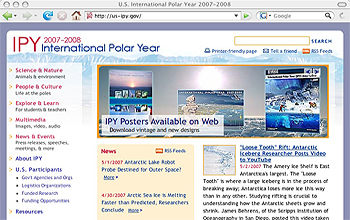Media Advisory 07-015
International Polar Year Web Portal Offers E-mail Alerts for Educators

The IPY Web portal now offers RSS feeds for immediate download of educational material.
May 9, 2007
This material is available primarily for archival purposes. Telephone numbers or other contact information may be out of date; please see current contact information at media contacts.
Teachers can now sign up for e-mail alerts immediately informing them when news about federally funded educational materials, classroom resources and information about opportunities to assist scientists in the field is added to the U.S. government's Web portal for the International Polar Year (IPY) 2007-2008.
Launched in February, the newly redesigned interagency portal--http://www.ipy.gov--now offers two RSS (short for "Real Simple Syndication") feeds to the public--one on "news and features" and one on "educational resources." Once users have set up their computers to read the RSS feeds, they automatically will receive e-mails as new links are added to the portal.
Directions for subscribing to the feeds are available on ipy.gov's home page.
IPY is a global scientific campaign that began in March 2007. It promises to advance our understanding of how the Earth's remote Polar Regions affect global climate systems, to bring about fundamental advances in many areas of science, and to fire the enthusiasm of young men and women for careers in science and engineering. The National Science Foundation (NSF) is the lead federal agency for IPY and maintains the IPY portal.
Current offerings in the ipy.gov "Explore and Learn" section include links to
- the "NASA Polar Express," the National Aeronautics and Space Administration's storehouse of multimedia information about the Polar Regions of the Earth, the Moon and Mars.
- a collection of images and illustrations of seals and whales maintained by the National Oceanic and Atmospheric Administration's National Marine Mammal Laboratory.
- and a link to NSF's award-winning Web site on the Amundsen-Scott South Pole Station.
- the NSF-funded ARMADA Project, which allows K-12 teachers to participate in ocean, polar, and environmental science research.
- lesson plans about Antarctica for students in grades 3-5 and 6-8 developed by the Boston National Public Radio affiliate in conjunction with a reporter's visit to the Antarctic Peninsula.
- a U.S. Geological Survey site that contains animations explaining how scientists track animal migrations in Alaska.
The IPY portal also lists Events and Exhibits including a June workshop at Ohio State University's Byrd Polar Research Center on "Teaching About the Cryosphere." A separate section provides images of IPY posters produced by federal agencies and federally funded research centers and links that allow teachers to download the posters for use in the classroom.
-NSF-
Media Contacts
Peter West, NSF, (703) 292-7761, email: pwest@nsf.gov
Related Websites
The U.S. government's International Polar Year Web portal: http://www.ipy.gov
The U.S. National Science Foundation propels the nation forward by advancing fundamental research in all fields of science and engineering. NSF supports research and people by providing facilities, instruments and funding to support their ingenuity and sustain the U.S. as a global leader in research and innovation. With a fiscal year 2023 budget of $9.5 billion, NSF funds reach all 50 states through grants to nearly 2,000 colleges, universities and institutions. Each year, NSF receives more than 40,000 competitive proposals and makes about 11,000 new awards. Those awards include support for cooperative research with industry, Arctic and Antarctic research and operations, and U.S. participation in international scientific efforts.
Connect with us online
NSF website: nsf.gov
NSF News: nsf.gov/news
For News Media: nsf.gov/news/newsroom
Statistics: nsf.gov/statistics/
Awards database: nsf.gov/awardsearch/
Follow us on social
Twitter: twitter.com/NSF
Facebook: facebook.com/US.NSF
Instagram: instagram.com/nsfgov
